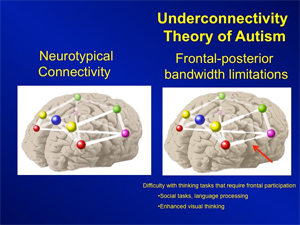ACADEMIA
Unlocking Autism's Mysteries: CMU's Marcel Just Uses New Brain SuperComputer Modeling To Predict Autistic Brain Activity, Behavior
Predictions Will Provide Scientists With Clear Targets for Autism Intervention and Treatment Therapies
New research from Carnegie Mellon University's Marcel Just provides an explanation for some of autism's mysteries — from social and communication disorders to restricted interests — and gives scientists clear targets for developing intervention and treatment therapies.{hwdvs-player}id=407|height=240|width=320|tpl=playeronly{/hwdvs-player}
Autism has long been a scientific enigma, mainly due to its diverse and seemingly unrelated symptoms until now.
Published in the journal "Neuroscience and Biobehavioral Reviews," Just and his team used brain imaging and supercomputer modeling to show how the brain's white matter tracts — the cabling that connects separated brain areas — are altered in autism and how these alterations can affect brain function and behavior. The deficiencies affect the tracts' bandwidth — the speed and rate at which information can travel along the pathways.
"White matter is the unsung hero of the human brain," said Just, the D.O. Hebb Professor of Psychology within CMU's Dietrich College of Humanities and Social Sciences and director of the university's Center for Cognitive Brain Imaging. "In autistic individuals, we can measure the quality of the white matter, and our computer model can predict how coordinated their brain activity will be. This gives us a precise account of the underlying alterations affecting autistic thought."
These findings build on Just's 2004 influential "Frontal-Posterior Underconnectivity Theory of Autism," which first discovered and explained that the synchronization of the activation between frontal and posterior brain areas is lower in autism. Since then, Just and his team have used more advanced imaging technologies, particularly diffusion imaging of white matter and sophisticated supercomputer models to uncover that the white matter is also altered in autism. Using their supercomputer model, they can relate the poorer quality of the white matter — connecting frontal and posterior brain areas — to the poorer synchronization in the frontal and posterior areas in individual people with autism.
The supercomputer model is able to solve some visual puzzles called the Tower of London (used in neuropsychological testing of frontal lobe function) through the coordinated activity of several computational systems that correspond to frontal and posterior brain areas. The model makes it possible to manipulate the communication bandwidth between the frontal and posterior areas. The findings were that the inter-regional synchronization of activation in a particular individual's brain could be predicted by calibrating the model's frontal-posterior communication bandwidth to the quality of that individual's white matter. Furthermore, the autism model solved the problems by relying less on frontal executive functioning and more on posterior "visual thinking."
"The brain's processing of social information is performed by a network of areas, some of which are frontal, and some of which are posterior," Just explained. "Social impairments in autism are likely caused by the poor frontal-posterior connectivity. Similarly, language comprehension is performed by a network of frontal and posterior areas, and once again, poor connectivity may impair that network's functioning."
Just added, "This tells us where the problem lies in autism. We can now focus on designing therapies that attempt to either improve the white matter — something we have already proven is possible through behavioral interventions — or help the brain develop work-around strategies."
In a groundbreaking study published in 2009, Just and his colleagues showed for the first time that compromised white matter in children with reading difficulties could be repaired with extensive behavioral therapy. Their imaging study showed that the brain locations that had been abnormal prior to the remedial training improved to normal levels after the training, and the reading performance in individual children improved by an amount that corresponded to the amount of white matter change.
"This new research and model makes way for modifying people's brains and possibly helping people with autism. It also points at the likely source of autism," Just said.
In addition to autism, these findings also have implications for a number of other psychiatric illnesses that involve white matter deficiencies, such as schizophrenia and Alzheimer's disease, providing a way to relate the anatomical deficiencies to thought processes.
The Autism Centers of Excellence, National Institute of Child Health and Human Development and the Office of Naval Research funded this research.
For more information on this study and where leading cognitive neuroscientist Marcel Just sees this research going in the immediate future, watch this video: http://youtu.be/eSR94zW8mrA.
Related Links:
Autism as a Neural Systems Disorder: A Theory of Frontal-Posterior Underconnectivity [pdf]
Carnegie Mellon Scientists Discover First Evidence of Brain Rewiring in Children
Altering Cortical Connectivity: Remediation-Induced Changes in the White Matter of Poor Readers (pdf)
New CMU Brain Imaging Research Reveals Why Autistic Individuals Confuse Pronouns

